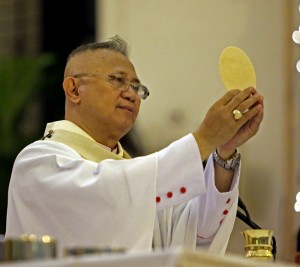Aspire to be holy despite challenges and pain, and go make a difference.
This was the message of Cebu Archbishop Jose Palma for the New Year’s celebration to usher in 2014, declared as the “Year of the Laity” by the Catholic Bishops’ Conference of the Philippines.
The Church wants to emphasize the role of the Catholic lay faithful who are all “called to be saints” and “sent forth as heroes” of evangelization.
“It is very significant that the first Filipinos to be canonized as saints are lay people: San Lorenzo Ruiz who was a married adult and San Pedro Calungsod who was a single teenager. Both tell us that all Filipinos, old or young, married or single are called to be saints,” said the 63-year-old prelate.
“As missionaries, they encourage us to know and spread our Catholic faith here are abroad. As martyrs, they challenge us to strive to live our faith everyday even if it would entail suffering and death. As saints, they intercede for us,” he added.
Palma, who will celebrate his third anniversary as archbishop of Cebu on Jan. 13, 2014, challenged lay people to “go into the world of family, of business, of economics, of politics, of education, of the mass media and the social media” and make a difference.
“The faithful must strengthen their faith through reading the Gospel, seeking recourse to the sacraments, and contributing to the mission of new evangelization through their own simple means,” he said.
Palma also mentioned the big event on April 27 next year: the canonization of Blessed John Paul II.
The archbishop said Filipinos will always have a special regard and affection for the late pontiff who canonized St. Lorenzo Ruiz in Manila on Feb. 18, 1981 and beatified San Pedro Calungsod in Rome on March 5, 2000. Pope John Paul II also visited Cebu on Feb. 19 and 20, 1981 and preached about the sanctification of the Filipino family and married life.
“May he who had at heart the Filipino people when he was here on earth continue to inspire and guide us from heaven like a loving shepherd towards the dignity of the altar,” Palma said.
“My dear brothers and sisters, holy people have walked on our Philippine soil. They are but signs of the abundant graces God has for us, constantly inviting us to Himself,” he added.
Aside from welcoming 2014, the Catholic Church will also be celebrating two events on the first day of the year. In the liturgical calendar, the Church commemorates on Jan. 1 the Solemnity of Mary as the mother of God and the World Day of Peace.
Mary’s title as the “mother of God” has often been argued by non-Catholics who say that Mary is simply human and could not be elevated into a god.
The title of “Mary as the mother of God ” has been upheld by the doctrine of the Roman Catholic Church since 431 A.D. during the Council of Epehesus. The Council of Ephesus declared Mary as the mother of God because Jesus whom Mary bore was both man and God, and that both natures of Jesus could never be separated from each other.
The doctrine, which gives Mary the title “mother of God,” followed after the Dogma of the Divinity of Jesus on 325 A.D. during the Council of Nicea, which declared that Jesus is God and His divinity unites his being human.
Before, the church commemorated on Jan. 1 the circumcision of Jesus in connection with the Jewish tradition of circumcising a male child eight days after his birth.
Pope Paul VI declared Jan. 1 as the “Solemnity of Mary” in 1974 as the mother of God. Prior to that, Jan. 1 was also declared the World Day of Peace in 1967.
Jan. 1 is considered a “holy day of obligation” for all Catholics.
The Church declares as “holidays of obligation” Dec. 8 which commemorates the Solemnity of the Immaculate Conception; Dec. 25, which commemorates the birth of Jesus; and Jan. 1, the Solemnity of Mary as the mother of God.
Disclaimer: The comments uploaded on this site do not necessarily represent or reflect the views of management and owner of Cebudailynews. We reserve the right to exclude comments that we deem to be inconsistent with our editorial standards.

